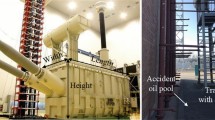Abstract
In this study, an extinguishing method using a rubber balloon filled with inert gas is proposed against fires in confined space such as spacecraft and space station. The proposed method has a possibility to increase extinguishing effectiveness of inert gas and decrease its volume amount needed for firefighting. In order to clarify the extinguishing characteristics, the blowoff experiments have been performed under normal gravity condition. CO2, N2, Ar and Ar + N2 mixture gases were used as an extinguishing gas and ethanol, 1-butanol and n-heptane were used to form a pool fire. The fuel pan diameters were varied from 47 mm to 94 mm. From the experimental results, it is found that there exists the extinguishment limit, which indicates the minimum inert gas volume needed for achieving flame extinguishment with the rubber balloon. By using the magnitude of the extinguishment limit value, the extinguishing ability of inert gas in the rubber balloon extinguishment can be evaluated. As a result, the effectiveness ranking of the inert gas in rubber balloon extinguishment agrees well with that of cup-burner tests. Moreover, it is found that when the size of the pool fire (fuel pan diameter) is same, the value of the lower heating value of fuel divided by the inert gas heat capacity at the extinguishment limit shows a certain constant value independent of inert gas and fuel species. As a result, the extinguishment limit of the rubber balloon extinguishing method is considered to be determined due to the balance between the heat release rate of the pool fire and the heat absorption rate of inert gas released from the bursting balloon. Thus, a rubber balloon can be used as an extinguishing capsule, by which a high concentration inert gas is easily delivered to the flame. In addition, it is much easier to grasp heat capacity effect of inert gas on flame extinguishment than the conventional methods, such as the cup-burner test.










Similar content being viewed by others
References
Grant G, Brenton J, Drysdale D (2000) Fire suppression by water sprays. Prog Energy Combust Sci 26:79–130
Ishizuka S, Tsuji H (1981) An experimental study of effect of inert gases on extinction of. laminar diffusion flames. Proc Combust Inst 18:695–703
Torikai H, Murashita T, Ito A, Metoki T (2011) Extinguishment of a laminar jet diffusion flame using a soap bubble filled with nitrogen gas. In: Proceedings of the 10th international symposium on fire safety science. International association for fire safety science, pp 557–568
Müller I, Strehlow P (2004) Rubber and rubber balloons. Springer, New York, pp 51–61
Saito N, Ogawa Y, Saso Y, Liao C, Sakei R (1997) Flame-extinguishing concentrations and peak concentrations of N2, Ar, CO2 and their mixtures for hydrocarbon fuels. Fire Saf J 27:185–200
Senecal JA (2005) Flame extinguishing in the cup- burner by inert gases. Fire Saf J 40:579–591
Takahashi F, Linteris GT, Katta VR (2007) Extinguishment mechanisms of coflow diffusion flames in a cup-burner apparatus. Proc Combust Inst 31:2721–2729
JSME (1995) Combustion handbook. The Japan Society of Mechanical Engineers, Maruzen, Tokyo, p 286
JSME (1983) Thermophysical properties of fluids. The Japan Society of Mechanical Engineers, Maruzen, Tokyo, pp 8–13
Kitajima A, Ueda T, Matsuo A, Mizomoto M (1996) Experimental investigation of the flame structure and extinction of turbulent counterflow non-premixed flames. Proc Combust Inst 26:137–143
Peters N (2000) Turbulent combustion. Cambridge University Press, Cambridge, pp 170–190
Author information
Authors and Affiliations
Corresponding author
Additional information
Publisher's Note
Springer Nature remains neutral with regard to jurisdictional claims in published maps and institutional affiliations.
Rights and permissions
About this article
Cite this article
Torikai, H. Extinguishing Characteristics of a Pool Fire with a Rubber Balloon Filled with Inert Gases. Fire Technol 56, 385–399 (2020). https://doi.org/10.1007/s10694-019-00929-2
Received:
Accepted:
Published:
Issue Date:
DOI: https://doi.org/10.1007/s10694-019-00929-2




